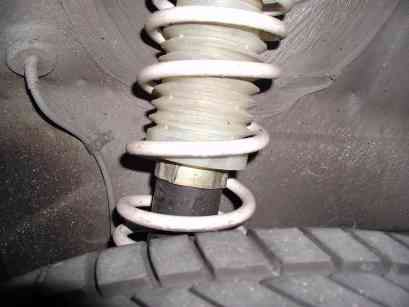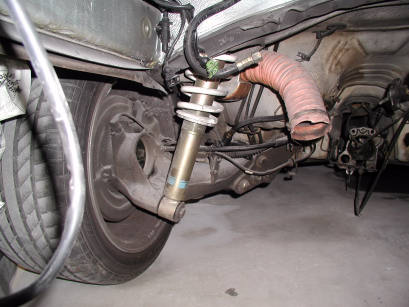|
C o m p l e t e 9 6 4 |
Suspension |
|||
|
Whilst the basic theory behind the 964 suspension is similar to the preceding Carrera 3.2- Macpherson/rigid lower front arms and semi trailing arms in the rear, the actual execution of the suspension was significantly different. This could be attributed to two key changes in the 964-
The new four wheel drive mechanism essentially restricted the ability for the 964 to utilise the traditional torsion bar type suspension in the front, whilst the G50 gearbox, which was longer than the previous 915 gearbox required that the rear torsion bars be "broken" or relocated to house the longer gearbox. This resulted in coil over type shocks being utilised on lower cast aluminium A arms. The key advantage of this was that the old torsion bars utilised in the 3.2 did not allow for fore and aft movement of the front suspension arms, which in turn translated into an unsettled ride over sharp bumps. The coils, conversely, permitted the Porsche engineers to build in a degree of fore/aft compliance of the suspension arms, which in turn enabled the front wheels of the 964 to move backwards slightly when hitting a sharp bump. This would in turn reduce the impact and the associated unsettling behaviour that affected the cars stability. At the same time, negative scrub radius was incorporated in the front suspension geometry (the 3.2 had positive scrub). Together with the assistance of the ABS, this gave a degree of steering correction when the front wheels began to slip. The four wheel drive and two wheel drive cars had identical suspension units. The rear suspension was also designed to combat a natural tendency of trailing arms to toe out whenever lateral braking forces were applied. However, given the trailing arm design, any clever attempts by the Porsche engineers to completely iron out all the bugs of the chassis would not occur until the complete redesign of the suspension system with the arrival of the 993. In spite of the limitations, it was still determined that the 964 was an easier car to handle than the previous incarnations of the 911. Indeed, the Carrera 4, whilst suffering from noticeable understeer when compared to its two wheel drive brother, was deemed to be an extremely competent driving machine for the less experienced driver. This was partly attributable to the "significant" drive to the front wheels. By comparison, the decreased understeer of the Carrera 2, resulted in a car that was considered a more entertaining ride for the experienced driver. There has been some confusion over the key differences between the Carrera 2 and Carrera 4 suspension (though there have been no arguments over the fact that the 965 Turbos suspension was significantly different!). Based on various reference material on hand (Porsche 911- Forever Young by Tobias Aichele and Original Porsche 911 by Peter Morgan), and my discussions with various Porsche mechanics, it would appear that the suspension of the 964 Carrera 2 and 4 are basically identical except for the absence of drive shafts on the Carrera 2. Two key differences in the various models are as follows-
Another important production change during the life of the 964 involved the rear shocks and springs (and the associated mounting points on the chassis) which were changed in 1991 (shorter springs and dampers) to provide more space for roof storage of the convertible model. From 1991 a sport suspension option was also provided for both the Carrera 4 and 2 models (this was not easily retrofitted to pre 1991 models given the completely different mounting points). The package comprised four revalved dampers (stiffer Boge units), a thicker front antisway bar (up to 22mm from 20mm) and significantly stiffer rear springs. The Turbo models suspension was further upgraded to include wider suspension arms, even stiffer springs and a combination 21mm front/22mm rear antisway bars. Overall ride height was 20mm lower than the standard 964 Carrera 2 or 4 models. [TO MAIN MENU] [TO HISTORY MENU]
|
Front strut detail through wheel arch (non standard Techart spring)
Rear coil over detail (non original Tecahrt springs and Bilstein dampers |
|||

